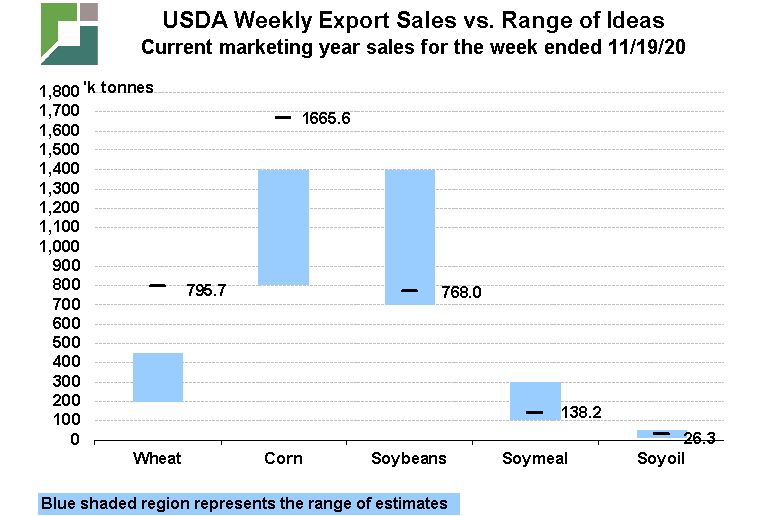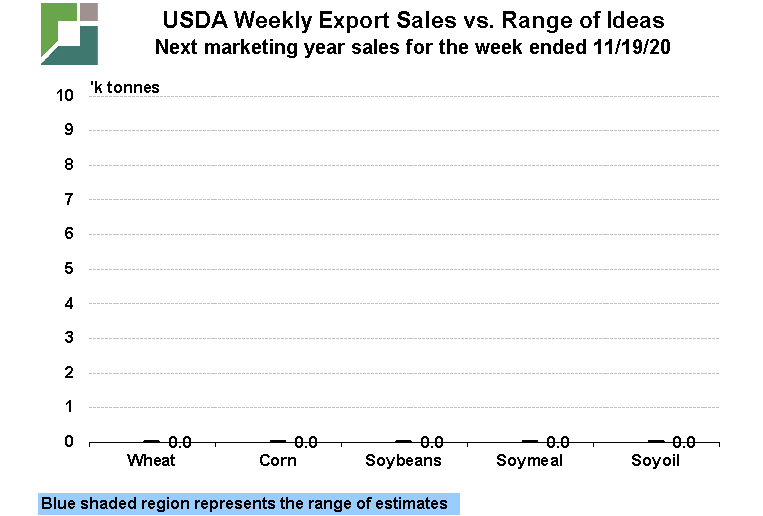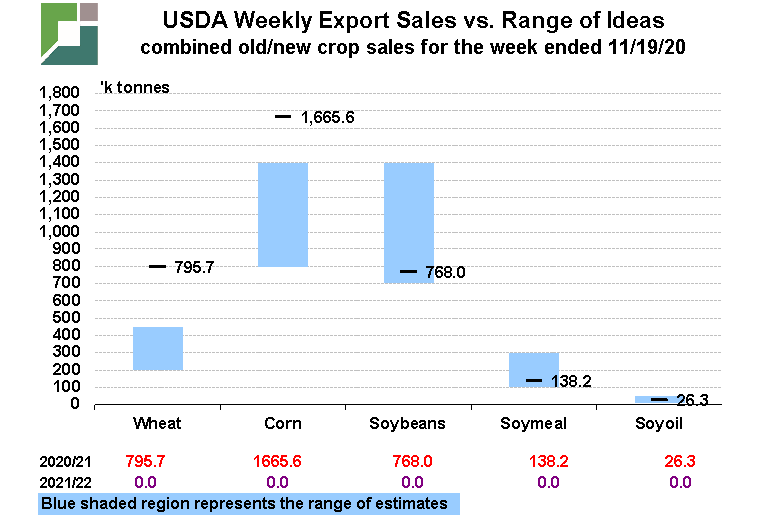-Soybean sales at bottom of expectations
-Corn sales higher than expected
-Wheat sales solidly higher than expected – marketing year high
-SBM sales at bottom of expectations/SBO sales as expected
U.S. soybean sales, for the week ended 11/19/20, were easily a marketing year low at 768k tonnes (28.2 million bushels), dropping sharply from the previous four weeks’ sales of 46.0-59.6 million bushels, coming in at the very bottom of market expectations of 700k-1.4 MMT and were less than half last year’s same-week sales of 61.2 million bushels. New net sales to China for the week were only 251k tonnes, putting their total purchases so far at 29.2 MMT vs 9.3 MMT at this time last year. Total commitments of 1.908 billion bushels continue to run sharply above last year’s 928 million bushels given the previously-aggressive Chinese buying and will require soybean sales to only average roughly 8.2 million bushels/week over the remaining nine months of the marketing year in order to reach the USDA’s 2.200 billion bushel export projection vs last year’s 20.4 mil bu/week average from this point forward. While a considerable slowdown in soybean sales from December forward is commonplace in most years, this year’s uber-focus on the demand situation may result in feelings of disappointment as sales numbers slow.
U.S. corn sales last week were solid at 1.666 MMT (65.6 million bushels), beating market expectations of 800k-1.4 MMT and rebounding strongly from the previous two weeks’ disappointing sales of 24.8 million and 38.5 million bushels. New Chinese buying of 76k tonnes was reported this week, but the largest reported sales by far went to Mexico with 556k tonnes. There were new net sales of 524k tonnes to unknown this week, as well, though. Total commitments of 1.436 billion bushels remain sharply above last year’s 554 million. Given the USDA’s record 2.650 billion bushel export projection, corn sales will still need to run at an average pace of 29.3 million bushels/week through the end of the marketing year, nearly identical to last year’s 30.0 million/week average despite the sharply higher level of sales already on the books. China now has 11.0 MMT of U.S. corn officially on the books, while there are also 5.8 MMT in sales to unknown on the books vs only 1.2 MMT a year ago, with a decent portion of those likely Chinese, as well.
U.S. wheat sales last week were a marketing year high 796k tonnes (29.2 mil bu), sharply outpacing market expectations of only 200-450k tonnes, well above the last eight weeks’ average sales pace of 17.3 million bushels/week and beating last year’s same-week sales of 22.5 million bushels. The strong sales can be at least partially attributed to new Chinese buying of 203k tonnes (HRW and white), with 130k tonnes also previously reported as “unknown” being switched to China, as well. China now has 1.11 MMT of U.S. wheat on the books. Total commitments of 663 million bushels are up 11% from last year’s 596 million, leaving sales needing to average roughly 12.2 million bushels/week through the end of May in order to reach the USDA’s 950 million bushel export projection vs last year’s 14.6 million/week average.
U.S. soybean meal sales of 138k tonnes were towards the bottom of market expectations of 100-300k tonnes, down from the previous week’s 182k tonnes and were a marketing year low through the first 8 weeks of 2020/21. Total commitments are still up nearly 3% from last year, though, vs the USDA projecting a 4% decline in exports this year. SBM sales will need to average roughly 153k tonnes/week vs last year’s 163k/week in order to reach the USDA’s annual export projection. Soybean oil sales of 26.3k tonnes were within expectations of 12-50k tonnes and bested last year’s same-week sales of 14.8k, but inevitably slipped from the previous two weeks’ very strong sales of 45k and 88k tonnes. Given the strong sales the last two weeks, total commitments are up a solid 21% from last year vs USDA projecting an 8% decline in exports this year. The fate of the Argentine crop is likely to have a considerable impact on ultimate size of the U.S. export program this year.



